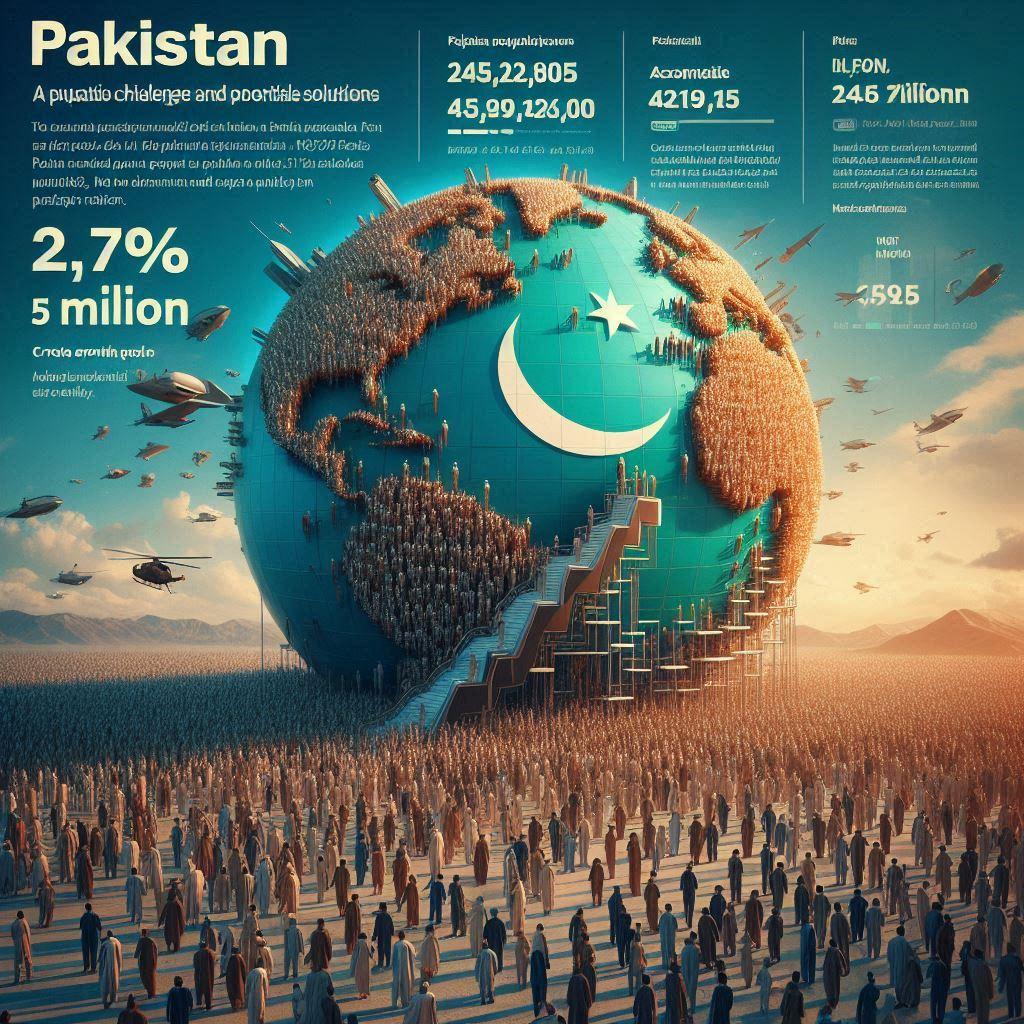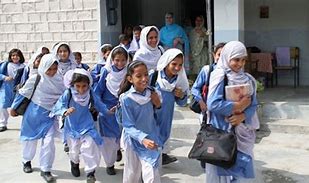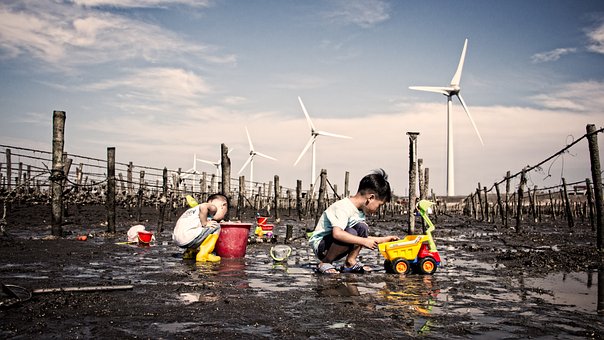In 2024, Pakistan’s population is estimated at around 245,209,815 (more than 245 million), reflecting a 1.96% increase from 2023. Based on United Nations data, this growth rate presents significant challenges in accommodating an additional 5 million people annually. This amplifying rise is an immense challenge and hurdle in the development of Pakistan. By addressing these challenges, we can reach some potential solutions.
Challenges
- Economic Well-being: Ensuring prosperity for a rapidly growing population.
- Job Creation: Generating employment opportunities.
- Education and Skills Training: Equipping the workforce with necessary skills.
- Infrastructure Development: Building adequate housing, transportation, and healthcare facilities.
- Social Safety Nets: Providing support through cash transfers, food security programs, and healthcare.
- Inclusive Economic Growth: Addressing income inequality and ensuring equal opportunities.
Solutions
Facilitating economic well-being for an additional 5 million people annually is a significant challenge. Here are some strategies that can help:
- Job creation: Encourage industries to create new job opportunities, focusing on sectors with high growth potential.
- Education and skills training: Invest in education and vocational training to equip the growing population with in-demand skills.
- Entrepreneurship support: Foster entrepreneurship by providing resources, funding, and mentorship to new businesses.
- Infrastructure development: Invest in infrastructure, such as housing, transportation, and healthcare, to accommodate the growing population.
- Social safety nets: Implement or strengthen social safety nets, like cash transfers, food security programs, and healthcare initiatives.
- Agricultural development: Enhance agricultural productivity to ensure food security and create jobs in the sector.
- Urban planning: Implement effective urban planning to manage the growing population in cities.
- Inclusive economic growth: Promote inclusive economic growth by addressing income inequality and ensuring opportunities for all segments of society.
- Investment in human capital: Focus on investing in human capital, including healthcare, education, and skills development.
- Governance and policy reforms: Implement effective policies to support economic growth and development.
Implementing these strategies requires a multi-faceted approach, involving government, private sector, and civil society collaboration.
Building New Cities is an Excellent Option
Building new cities can be an excellent option to accommodate a growing population, especially when combined with:
- Improved law enforcement: Ensuring public safety and security through effective policing and community engagement.
- Smart city planning: Designing cities with innovative infrastructure, sustainable energy, and efficient transportation systems.
- Inclusive zoning: Encouraging mixed-use development, affordable housing, and accessible public spaces.
- Green spaces: Incorporating parks, gardens, and green roofs to promote environmental sustainability and quality of life.
- Economic opportunities: Creating jobs, supporting local businesses, and fostering innovation hubs.
- Social services: Providing access to healthcare, education, and community programs.
- Technology integration: Leveraging technology for efficient governance, public services, and citizen engagement.
Benefits of Building New Cities
- Planned growth: Controlled development, avoiding urban sprawl and environmental degradation.
- Innovation hubs: Encouraging entrepreneurship, research, and development.
- Sustainable living: Incorporating green technologies and reducing carbon footprint.
- Improved quality of life: Enhanced public services, safety, and community engagement.
- Economic growth: Creating new opportunities, jobs, and industries.
Examples of Successful New Cities
A few examples of successful new cities include:
Singapore: A Modern, Efficient, and Sustainable City-State
- Location: Southeast Asia, on the southern tip of the Malay Peninsula
- Land area: 720 square kilometers
- Population: 5.69 million (2020)
- Timeframe: Transformation began in the 1960s, with ongoing development
- Investment: SGD 1.1 trillion (USD 790 billion) in infrastructure development from 2011 to 2020
- Facilities: World-class public transportation, 95% of households with high-speed internet, 100% renewable energy target by 2050
- Statistics: 90% of residents live in public housing, 20% of land is dedicated to parks and green spaces, 50% reduction in carbon emissions since 2000
Masdar City (UAE): A Zero-Carbon, Zero-Waste City
- Location: Abu Dhabi, United Arab Emirates
- Land area: 1,483 acres (6 square kilometers)
- Population: 1,500 (2020), expected to grow to 40,000 by 2030
- Timeframe: Construction began in 2008, with phase 1 completion in 2020
- Investment: USD 18 billion
- Facilities: 100% renewable energy, electric vehicle transportation, green buildings, and a carbon-neutral district cooling system
- Statistics: 50% reduction in energy consumption, 50% reduction in water consumption, 100% waste recycling
Songdo International Business District (South Korea): A Smart City with Innovative Infrastructure
- Location: Incheon, South Korea
- Land area: 1,500 acres (6.1 square kilometers)
- Population: 100,000 (2020), expected to grow to 250,000 by 2025
- Timeframe: Construction began in 2003, with ongoing development
- Investment: USD 35 billion
- Facilities: Smart transportation systems, energy-efficient buildings, and a comprehensive data analytics platform
- Statistics: 40% reduction in energy consumption, 30% reduction in water consumption, 95% of residents with high-speed internet
Neom (Saudi Arabia): A Futuristic City Focused on Sustainability and Innovation
- Location: Tabuk Province, Saudi Arabia
- Land area: 26,500 square kilometers (10,230 square miles)
- Population: Expected to reach 1 million by 2030
- Timeframe: Construction began in 2020, with completion expected by 2030
- Investment: USD 500 billion
- Facilities: 100% renewable energy, advanced water management systems, and a focus on biotech, robotics, and advanced manufacturing
- Statistics: 100% carbon-neutral, 100% waste recycling, and a projected GDP of USD 100 billion by 2030
Note: Some statistics and figures are estimates or projections, as these cities are still under development.
Building New Cities in Pakistan
Potential locations: undeveloped regions, coastal areas, or near economic corridors
Designed with:
- Sustainability, innovation, and inclusivity in mind
- Modern infrastructure, efficient transportation, and green technologies
- A mixed-use development, affordable housing, and accessible public spaces
By building new cities focusing on the welfare of all, Pakistan can address its population growth challenge while improving quality of life, economic growth, and environmental sustainability.
Challenges in Building New Cities
Building new cities can help accommodate population growth, but whether they can accommodate every 5 million yearly increase depends on various factors.
Assuming an average city size of 1,000 square kilometers (386 square miles), which is a rough estimate for a modern city like Singapore or Masdar City, we can make some calculations:
5 million people per year / 250-500 people per square kilometer (a rough estimate for urban population density in the developed world) = 10,000 – 20,000 square kilometers of new city area needed per year
This translates to 10-20 new cities of average size per year.
A Complex Process
However, building new cities is a complex process that requires:
- Large land areas, often displacing existing ecosystems or communities
- Massive investments in infrastructure, including transportation, energy, water, and waste management
- Careful planning, design, and governance to ensure sustainability, livability, and economic viability
- Time, as building a new city can take decades, if not centuries
The global population growth rate is approximately 1.09% per annum, which translates to around 83 million people per year. While building new cities can help accommodate some of this growth, it is unlikely to keep pace with the yearly increase of 5 million people.
Alternative Approach
Instead, a combination of strategies will be necessary, including:
- Urban densification and infill development in existing cities
- Upgrading and expanding existing infrastructure
- Implementing sustainable urban planning and design principles
- Addressing population growth rates through education, family planning, and economic development initiatives
Conclusion
Building new cities can be part of the solution to address population growth, but it must be accompanied by a comprehensive approach to managing urbanization and population growth. This includes urban densification, upgrading existing infrastructure, implementing sustainable urban planning, and addressing population growth rates through education, family planning, and economic development initiatives.










